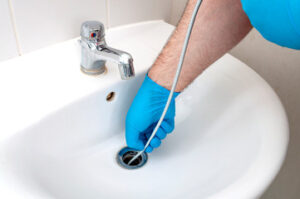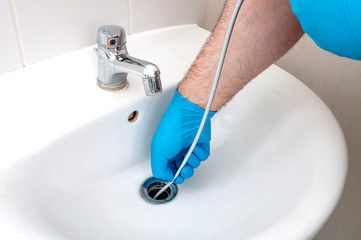Drain Cleaning Sarasota is the process of using mechanical devices to remove obstructions within a drainpipe. It also includes a thorough inspection of the entire pipe system. This service is important for the long-term health of your plumbing system.

Commercial drain cleaner solutions contain acids and can corrode pipes. You should always leave serious clogs to the professionals.
Hydro jetting is a drain cleaning method that uses high-pressure water to blast away pipe blockages and debris. It is very effective at removing stubborn clogs and is also useful for preventative maintenance. It can be used to clear out hair, soap scum, mineral buildup, and tree roots. It is a more accurate way to clean sewer lines than drain chemicals and can reach clogs that are buried underground. Hydro jetting is environmentally safe and can be done in residential homes.
Before using a hydro jet, the plumber will insert a camera into the sewer line to determine the cause of the clog. Once the clog is identified, the plumber will choose a suitable nozzle for the job. The nozzles are designed to rotate, so the water can blast the sides of the pipe and break up any blockages. After the clog is removed, the plumber will flush the drain with hot water to remove any remaining debris and ensure the pipe is fully cleaned.
The main advantage of hydro jetting is that it does not use chemicals, which can harm the environment and your pipes. In addition, it does not require any digging or excavation to clean a sewer line. The only disadvantage of this method is that it can damage pipes if not used correctly. This is why it is important to hire a licensed and insured professional plumber to perform the service.
Unlike drain snakes, hydro jetting can eliminate odors in the plumbing system and also reduce future blockages. The powerful force of the water breaks up and washes away bacteria that cause foul odors. It is also a safer method than chemical drain cleaners, which can be dangerous to children and pets.
Hydro jetting is the best option for clearing a large drain or sewer line clog. It can also be used to remove a buildup of grease and other materials. It can also be used to replace old, damaged or corroded pipes. However, it is important to remember that hydro jetting can damage your pipes if not performed by a licensed and experienced professional plumber.
Plungers
When a sink, toilet, or shower drain gets clogged, the first thing most homeowners think of is grabbing their plunger. It is an inexpensive and effective solution to a drain problem that can save on plumber fees and prevent damage to pipes. Using a plunger properly can help clear stubborn drain clogs in minutes and doesn’t require any chemicals, making it an ideal option for homeowners. The key to success with a plunger is to create a strong seal and to pump in smooth, controlled thrusts. It is also important to keep the plunger clean, dry, and away from harsh chemicals. Finally, it is helpful to store plungers separately so that you know which one to use for a specific drain.
When most people picture a plunger, they imagine the classic image of a rubber suction cup on a wooden stick. While this is the most common type of plunger, there are many different types that can be used for a variety of situations. The best plunger for the job depends on the type of clog and the size of the pipe. For example, a taze plunger is ideal for removing stubborn sewer line clogs.
A taze plunger has a long, flexible rod with a bellows-like design. It is designed to create a vacuum and push up debris that has accumulated in the pipe. It is an excellent choice for clogs in sewer lines, which can cause sewage to back up into the home and pose health hazards. It is also an effective solution for removing blockages in bathtubs and shower drains.
In addition to plungers, homeowners can also use air compressors and air blowers to remove clogs. These tools work in a similar way to plungers, but they are more powerful and can break up larger debris. Air blowers can also be used to clear large trees and branches that have fallen into a drain.
Both plungers and air pressure cleaners are environmentally friendly and do not harm wildlife. However, if a clog is severe or doesn’t respond to these treatments, it may be time to call a professional. Clogged drains can lead to odor problems, sewage backup into the home, and flooding. A high-pressure drain cleaner can restore proper drainage quickly and without damaging your pipes or contaminating the environment.
Wire hangers
Keeping your drains free from clogs is one of the key factors in keeping your home plumbing system in good condition. Clogged drains can cause foul smells, overflowing sinks and tubs, and drain flies. If you have a serious clog, it may be necessary to call in professional drain cleaners. However, you can also try using some common household tools to clear your drains.
A wire coat hanger can make a great DIY drain snake. You can use this tool to clear a toilet drain or other household drains. First, make sure that the bend in your hanger is small enough to fit into the pipe. Then, wrap one end of the hanger with a rag and secure it with duct tape. If you don’t have a rag, you can wrap the hanger with rubber bands instead.
Next, pour a liberal amount of baking soda into the clogged drain. Follow this with a cup of distilled vinegar. The acid in the vinegar can dissolve hard deposits and kill bacteria that cause disease outbreaks. Allow the mixture to sit for an hour or more. After the time has passed, flush the drain with hot water to remove the clog and cleaning solution.
If you don’t have a plunger, you can also use a wet and dry shop vacuum to unclog your drains. Make sure to turn off the air vent before using this method. It is also important to wear protective gloves and eyewear. The fumes from the caustic soda can be dangerous if they come into contact with your skin or eyes.
Another DIY drain cleaning recipe involves combining equal parts of boiling water and baking soda. This is a very effective way to clear a slow-draining drain. Boiling water can help break up congealed fats and oils, while baking soda will disintegrate organic buildup.
You can also use a wire hanger to remove hair from your shower or sink drains. Just be careful not to snag or pull on the hanger. If the clog is too large for this method, you can always try pouring hot boiling water down the drain and using a plunger to loosen the clog.
Chemical cleaners
Keeping drains clean is important because clogged drains can lead to plumbing leaks. They can also lead to unpleasant odors in the home caused by rotting material. Ultimately, it can also affect the health of people in the home. The rotting material can cause infections and other health problems. A clogged drain can also block up the flow of water in a home, leading to floods or water backups. If these issues are not addressed quickly, they can lead to major damage to a home and expensive repairs.
Chemical drain cleaners work by using a combination of chemicals to break down and dissolve clogs. They contain surfactants, which are chemicals that orient themselves at the interface between water and a solid. These chemicals bind to the surface of the solid and create a strong force that pulls it away from the pipe walls. These chemical cleaners are effective at cleaning most types of clogs. They are most effective on organic soils such as hair, grease, and soap scum. However, they are less effective on inorganic clogs.
While chemical drain cleaners can be effective, they can be dangerous if misused. They produce harmful fumes that can irritate the eyes, skin, and the lining of the respiratory system. They can also be toxic if ingested or inhaled in large quantities. Therefore, it is recommended to wear gloves, a mask, and protective eyewear when handling these products.
In addition, chemical cleaners can be damaging to pipes. They generate a lot of heat during the chemical reaction, which can melt or warp PVC pipes. They can also cause metal pipes to bulge and crack. Therefore, they should be used only as a last resort. Moreover, they can be harmful to the environment, as they can release toxic waste into the groundwater. Lastly, they can also kill the bacteria in a septic tank, which is essential for breaking down waste.

